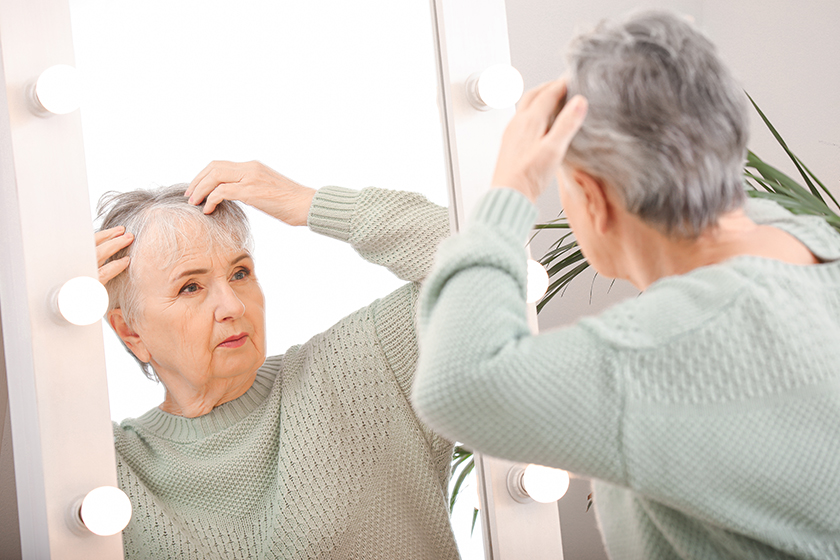As we age, our hair undergoes various changes, often leading to concerns that can be both distressing and challenging. For older adults, understanding and addressing these changes is key to maintaining healthy, vibrant hair. In this comprehensive guide, we will explore seven effective strategies to prevent common seniors’ hair problems.
Understanding the Changes in Hair with Age
Before diving into solutions, it’s essential to understand what happens to hair as we grow older. Hair often becomes thinner, drier, and more brittle due to changes in hormones, nutrient absorption, and natural oil production in the scalp. These changes can lead to issues such as hair thinning, dryness, breakage, and a lackluster appearance. By recognizing these changes, older adults can take proactive steps to address and manage their hair health effectively.
Maintaining a Nutrient-Rich Diet
A balanced, nutrient-rich diet plays a critical role in maintaining healthy hair. For older adults, incorporating foods high in vitamins and minerals that promote hair health is crucial. Key nutrients include protein, iron, omega-3 fatty acids, vitamin E, and zinc. Foods like fish, nuts, leafy greens, and lean meats can provide these essential nutrients, helping to strengthen hair and promote growth.
Gentle Hair Care Practices
As hair becomes more fragile with age, gentle hair care practices become increasingly important. This includes using a soft-bristled brush, avoiding excessive heat styling, and choosing mild, moisturizing hair care products. Older adults should also avoid tight hairstyles that can pull on the scalp, leading to hair breakage and loss.
Staying Hydrated and Moisturized
Dry hair is a common issue among older adults. To combat this, it’s important to stay hydrated by drinking plenty of water and using hydrating hair care products. Look for shampoos and conditioners with natural oils and moisturizing ingredients that can replenish the hair’s natural oils, lost through aging. Hydrating masks and leave-in conditioners can also be beneficial, providing deep nourishment and helping to lock in moisture, thereby maintaining the hair’s elasticity and preventing brittleness.
Regular Scalp Care
A healthy scalp is the foundation of healthy hair. Older adults should incorporate scalp massages into their routine to stimulate blood flow, promoting hair growth and health. Additionally, using gentle exfoliating products can help remove dead skin cells and buildup, fostering a healthy scalp environment. This can be complemented by occasional treatments with essential oils like peppermint or tea tree oil, which can invigorate the scalp and aid in maintaining its health, thus contributing to stronger and healthier hair growth.
Protecting Hair from Environmental Damage
Environmental factors like sun exposure, wind, and pollution can exacerbate hair problems. Older adults should protect their hair by wearing hats or scarves when outdoors, and by using hair products with UV protection. This helps prevent sun damage, which can lead to hair thinning and color fading. Additionally, using anti-pollution hair products that create a protective barrier can be beneficial in urban environments, safeguarding the hair from the damaging effects of environmental aggressors.
Regular Trimming and Professional Advice
Regular trims can help maintain hair health by removing split ends and reducing breakage. Additionally, consulting with a professional hairstylist or a trichologist (a scalp and hair specialist) can provide personalized advice and treatments tailored to individual hair concerns. They can offer insights into the latest hair care technologies and products that are specifically designed for aging hair, ensuring that your hair care regimen is up-to-date and effective in addressing your unique hair needs.
Embracing Natural Changes with Confidence
Finally, it’s important for older adults to embrace the natural changes that come with aging hair. This can mean accepting graying hair or adjusting to a new texture. Finding a hairstyle that suits the hair’s current condition and personal style can boost confidence and reduce the stress associated with hair changes. Experimenting with different styles and colors, potentially embracing the silver and gray tones, can lead to discovering a new look that not only embraces these changes but also highlights the individual’s unique beauty and personality.
A Positive Outlook on Hair Health
Caring for hair as we age might require new routines and approaches, but it can be a rewarding and empowering process. By embracing these seven strategies, older adults can effectively manage common hair problems, maintaining healthy and beautiful hair through their golden years.
Remember, hair is a reflection of overall health and well-being. By taking care of your hair, you’re also nurturing your body and mind, reinforcing a positive self-image and embracing the beauty of aging with grace and confidence.







